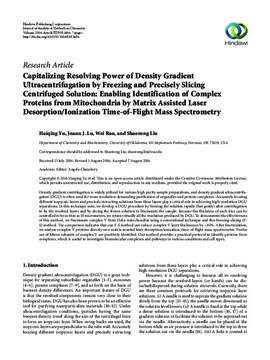| dc.creator | Yu, Haiqing | |
| dc.creator | Lu, Joann J. | |
| dc.creator | Rao, Wei | |
| dc.creator | Liu, Shaorong | |
| dc.date.accessioned | 2016-09-19T16:48:49Z | |
| dc.date.available | 2016-09-19T16:48:49Z | |
| dc.date.issued | 2016 | |
| dc.identifier.citation | Haiqing Yu, Joann J. Lu, Wei Rao, and Shaorong Liu, “Capitalizing Resolving Power of Density Gradient Ultracentrifugation by Freezing and Precisely Slicing Centrifuged Solution: Enabling Identification of Complex Proteins from Mitochondria by Matrix Assisted Laser Desorption/Ionization Time-of-Flight Mass Spectrometry,” Journal of Analytical Methods in Chemistry, vol. 2016, Article ID 8183656, 7 pages, 2016. doi:10.1155/2016/8183656 | en_US |
| dc.identifier.uri | https://hdl.handle.net/11244/45049 | |
| dc.description.abstract | Density gradient centrifugation is widely utilized for various high purity sample preparations, and density gradient ultracentrifugation (DGU) is often used for more resolution-demanding purification of organelles and protein complexes. Accurately locating different isopycnic layers and precisely extracting solutions from these layers play a critical role in achieving high-resolution DGU separations. In this technique note, we develop a DGU procedure by freezing the solution rapidly (but gently) after centrifugation to fix the resolved layers and by slicing the frozen solution to fractionate the sample. Because the thickness of each slice can be controlled to be as thin as 10 micrometers, we retain virtually all the resolution produced by DGU. To demonstrate the effectiveness of this method, we fractionate complex V from HeLa mitochondria using a conventional technique and this freezing-slicing (F-S) method. The comparison indicates that our F-S method can reduce complex V layer thicknesses by ~40%. After fractionation, we analyze complex V proteins directly on a matrix assisted laser desorption/ionization, time-of-flight mass spectrometer. Twelve out of fifteen subunits of complex V are positively identified. Our method provides a practical protocol to identify proteins from complexes, which is useful to investigate biomolecular complexes and pathways in various conditions and cell types. | en_US |
| dc.description.sponsorship | This work is partially sponsored by the National Institutes of Health (R21GM104526) and National Science Foundation (CHE1011957). | en_US |
| dc.format.extent | 8 pages | |
| dc.format.extent | 2,873,231 bytes | |
| dc.format.medium | application.pdf | |
| dc.language | en_US | en_US |
| dc.relation.requires | Adobe Acrobat Reader | |
| dc.subject.lcsh | Centrifugation, Density gradient | en_US |
| dc.subject.lcsh | Ultracentrifugation | en_US |
| dc.subject.lcsh | Cryobiology | en_US |
| dc.subject.lcsh | Proteins -- Separation -- Technique | en_US |
| dc.subject.lcsh | Resolution (Optics) | en_US |
| dc.subject.lcsh | Time-of-flight mass spectrometry | en_US |
| dc.title | Capitalizing resolving power of density gradient ultracentrifugation by freezing and precisely slicing centrifuged solution : enabling identification of complex proteins from mitochondria by matrix assisted laser desorption/ionization time-of-flight mass spectrometry | en_US |
| dc.type | Article | en_US |
| dc.type | text | |
| dc.description.peerreview | Yes | en_US |
| dc.identifier.doi | 10.1155/2016/8183656 | en_US |
| ou.group | College of Arts and Sciences::Department of Chemistry and Biochemistry | en_US |
